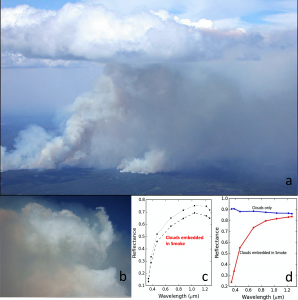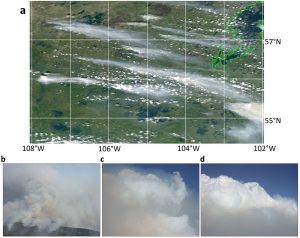30 August 2016
Wildfire smoke hacks clouds
Posted by larryohanlon

Airborne images from NASA’s P-3 aircraft: a) forest fire smoke plumes rising towards clouds over Saskatchewan on June 30, 2008; b) clouds embedded in smoke seen on July 2; c) and d) show data collected by NASA’s Cloud Absorption Radiometer during the flights. Credit: Aqua/MODIS/NASA/AGU
Plumes of wildfire smoke envelop and alter clouds, potentially affecting local weather, according to new research based on serendipitous airborne measurements of clouds in smoke from Canadian fires. The new data confirms clouds embedded in smoke are likely to warm up the atmosphere around clouds, causing the clouds to dissipate faster.
The new research comes from NASA’s Cloud Absorption Radiometer (CAR), which was flown over Saskatchewan during the NASA-sponsored Arctic Research of the Composition of the Troposphere from Aircraft and Satellites (ARCTAS) experiment in the summer of 2008. The aircraft carrying the instrument encountered clouds embedded in smoke and was able to fly around them, gathering detailed data on how sunlight was being reflected and absorbed by the clouds and the smoke particles, or aerosols.
“At first we were looking at the data for aerosols only, using observations from the aircraft to quantify and characterize the light scattering by these particles,” said Ritesh Gautam of the Indian Institute of Technology Bombay, Mumbai. But the unexpected combination of smoke and clouds offered a whole new research opportunity, said Gautam, lead author of a paper reporting the new research in The Journal of Geophysical Research–Atmospheres, published by the American Geophysical Union.
Clouds reflect sunlight back into space and have a net cooling effect on the climate. Aerosols, like smoke or dust, also reflect sunlight and have a net cooling effect on the climate, but how much sunlight they reflect depends on the composition of the aerosols, Gautam said. Smoke aerosols from fires, which contain a lot of soot particles, absorb sunlight, rather than reflect sunlight, in the atmosphere, he said.
Things really get complicated, however, when you add clouds and aerosols together, Gautam said.

a) Widespread forest fire smoke plumes on June 30, 2008, stretching hundreds of kilometers over Saskatchewan. Airborne pictures of (b) forest fire smoke on June 30, 2008, and (c), (d) clouds embedded in smoke on 2 July 2008. Credit: Aqua/MODIS/NASA/AGU
Smoke causes clouds to darken, which means less sunlight is being reflected back into space. That means more solar energy is being trapped between the clouds and the smoke, warming the air and affecting the local weather, Gautam said.
The data from CAR made it possible to look at the clouds close-up and from all angles – essentially a three-dimensional view, said Charles Gatebe of NASA’s Goddard Space Flight Center, principal investigator of the instrument and co-author of this study, who made these measurements aboard NASA P-3 aircraft.
In the new data from Saskatchewan, Gautam saw a “huge difference” in the measured amount of light reflected from clouds interacting with the smoke and those far away from the smoke. The amount of warming from clouds interacting with smoke also depends where the smoke is in relation to the clouds, he said.
When the clouds are embedded in smoke, heating occurs right around the clouds. This accelerates the process of evaporation of existing clouds, causing them to dissipate, and suppresses the upward flow of moisture from the surface needed to form new clouds, as reported in previous studies. The result is less cloud cover. (http://earthobservatory.nasa.gov/Features/SmokeClouds/).
When the smoke forms a layer above a certain type of lower-level clouds, the air is warmed above the clouds, forming an inversion layer, like those that trap smog over a city. The inversion layer can cause the lower-level cloud cover to increase and spread out, Gautam said. But these heating effects of smoke can vary for different types of clouds.
These observations show smoke is changing the clouds, which could affect local weather, according to the new study. Preliminary work on similar data collected in the past from clouds and smoke over the southeastern Atlantic Ocean appears to show the same results, Gautam said.
It also confirms some previous data of this phenomenon gathered from satellites. The satellite data provides a big picture view of smoke above or mixed with clouds, but is less detailed because the satellites can’t move around the clouds and smoke, and only provide a top view of the system, Gautam said.
“The aircraft spiraled down and circled around,” said Gautam, collecting a lot more information about exactly how sunlight is interacting with clouds and smoke than is possible from a satellite snapshot.
Although the new study sheds some light on the effects of smoke on clouds, whether the net cloud cover will increase or be reduced in response to heating due to smoke is still largely unknown, Gautam said. This makes it a highly intriguing research problem, which directly affects our weather and climate, especially in the scenario of climate change, he added.
Source:
Radiative characteristics of clouds embedded in smoke derived from airborne multiangular measurements, Gautam, et al., 2016, JGR-Atmospheres
Larry O’Hanlon is a freelance science writer, editor and social media manager. He manages the AGU blogosphere.



 GeoSpace is a blog on Earth and space science, managed by AGU’s Public Information staff. The blog features posts by AGU writers and guest contributors on all sorts of relevant science topics, but with a focus on new research and geo and space sciences-related stories that are currently in the news.
GeoSpace is a blog on Earth and space science, managed by AGU’s Public Information staff. The blog features posts by AGU writers and guest contributors on all sorts of relevant science topics, but with a focus on new research and geo and space sciences-related stories that are currently in the news.